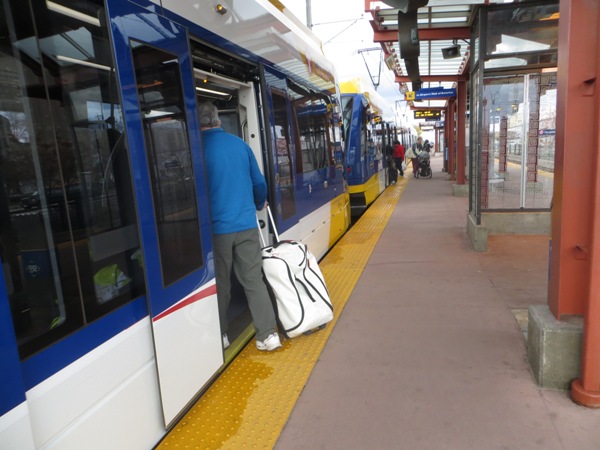The Mattapan Line deserves new rolling stock, but buses make no sense. It’s not that the PCCs which run the line are unreliable—they’re plenty reliable—but parts are hard to come by (some are custom made by a museum in Maine) and the fleet is a throwback to the 1940s, making the 1969-era Red Line cars look young by comparison. New, modern streetcars could each carry nearly double what a PCC does with more low-floor doors for far more efficient boarding. By spreading weight across three trucks (sets of wheels) instead of two, the whole “the bridges won’t support larger vehicles” straw man. (PCC: 18,000-21,000 lbs/truck, plus air conditioning units, Seattle streetcar: 22,000 lbs/truck.) The bridges likely need some work anyway, and a concrete deck to support buses weighs a heck of a lot more than ballast and track (buses need a lot of concrete). And the T is good at quickly replacing old bridges. So maybe you just replace the bridges.
 |
| The route of Track 61 and an extension to Andrew in yellow. |
It’s the route of Track 61 which is most intriguing, as it would make a last-mile connection between the Red Line and the Seaport, which currently requires a ride on two over-capacity transit lines (the Red Line to South Station and the Silver Line to the Seaport). For commuters from the south going to the Seaport, a transfer at Andrew would save five minutes of commute time, and (more importantly) it would pull some demand off of the Silver Line at rush hour, when buses run every minute-or-so at crush capacity and leave passengers on the platform. With some minor (seven figure) improvements (stations, overhead, a couple of interlockings), there is an unused rail corridor with mostly-existing rail on which the PCCs (or new rolling stock) could be run in relatively short order.
The key would be to find both funding and possibly a non-MBTA operator. (Power could be acquired from the adjacent MBTA facilities, but it could be run by a different organization. Let’s start with funding: there are mechanisms in place. Capital costs could come from a TIGER-type grant, and operating costs from a transportation management association or perhaps from the Mass Convention Center Authority or even MassPort, especially since they have hundreds of millions of dollars for parking garages in the area (maybe, uh, we shouldn’t build that parking garage, wait, don’t call it that).
 |
| Amazing! Trams/streetcars can have level boarding. (Minneapolis-Saint Paul “Metro”) |
As for the rolling stock: The current PCCs are inaccessible, but are made accessible with high-platforms along the Fairmount Line. This could be replicated along Track 61, especially since the stations would be built from scratch and fewer in number. (In theory: Andrew, Broadway, Convention Center, Black Falcon.) More likely would be low-platform modern trams (and by modern, I mean “flush with the platform”) to run on the line with PCCs used for supplemental service (weekends, middays, etc). It might be possible to strike a deal with the Seashore Trolley Museum to both use the Seashore-owned 5734 (which likely needs some rehab but ran within the past 20 years and has been stored underground at Boylston) and perhaps relocating some other MBTA equipment from there for an outpost of the Maine facility: a small, San Francisco-style rolling museum showing the transit history of the oldest subway in the country.
DMUs and commuter rail to the Seaport is a round-peg-square-hole issue. The scale is not really appropriate (especially if it is diesel, with more local particulate emissions in a high-density residential community) and the routing certainly isn’t. (There’s also the matter of significant single-track, which is easier to navigate with light rail equipment.) Moreover, with the Red Line adjacent at one end and the Silver Line at the other, it might be possible to simply tie in traction power from each end without building any new facilities, so the power costs would be minimized (overhead is cheap, substations are expensive). Track 61 shouldn’t be let to sit and fester for the next 25 years. But if we do something with it, let’s do something sensible.
